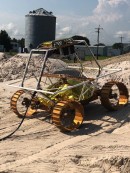Australia wants a piece of the moon, too, and has recently announced an agreement signed between its Space Agency and NASA, to develop a small rover that can operate on the lunar surface.
The partnership is part of NASA’s vast program Artemis for Moon exploration. Australia’s lunar rover project will be supported by the Trailblazer program, which is the country’s $150 million Moon to Mars initiative, announced in 2019.
Australia’s small rover will be semi-autonomous and will weigh no more than 44 lb (20 kg). Its purpose will be to collect regolith, which consists of broken rock and dust from the surface of the moon. The regolith will be transferred to an ISRU (in-situ resource utilization) system operated by NASA, on a commercial lunar lander.
NASA will attempt to extract oxygen from the lunar regolith, as the soil contains it in the form of compounds with elements such as silicon and iron. According to NASA, the Aussie-made rover will serve as a second means of collection that increases the chances of success, as the lander that delivers the rover will already include a mechanism for picking up lunar soil.
While this specific demonstration will be a small-scale one, in the future, NASA aims to develop much larger and capable such units. They would allow astronauts to create rocket fuel and other consumables using the resources on the Moon.
Australia’s rover is scheduled to fly to the lunar surface no earlier than 2026. So far, there haven’t been any other details revealed on the rover, but the Australian Space Agency assures us more information will be provided once the Trailblazer program opens later this year.
According to Enrico Palermo, head of the Australian Space Agency, the country is at the cutting-edge of robotics technology and systems for remote operations, which are going to be central to setting up a sustainable presence on the Moon and eventually supporting the human exploration of Mars.
Australia’s small rover will be semi-autonomous and will weigh no more than 44 lb (20 kg). Its purpose will be to collect regolith, which consists of broken rock and dust from the surface of the moon. The regolith will be transferred to an ISRU (in-situ resource utilization) system operated by NASA, on a commercial lunar lander.
NASA will attempt to extract oxygen from the lunar regolith, as the soil contains it in the form of compounds with elements such as silicon and iron. According to NASA, the Aussie-made rover will serve as a second means of collection that increases the chances of success, as the lander that delivers the rover will already include a mechanism for picking up lunar soil.
While this specific demonstration will be a small-scale one, in the future, NASA aims to develop much larger and capable such units. They would allow astronauts to create rocket fuel and other consumables using the resources on the Moon.
Australia’s rover is scheduled to fly to the lunar surface no earlier than 2026. So far, there haven’t been any other details revealed on the rover, but the Australian Space Agency assures us more information will be provided once the Trailblazer program opens later this year.
According to Enrico Palermo, head of the Australian Space Agency, the country is at the cutting-edge of robotics technology and systems for remote operations, which are going to be central to setting up a sustainable presence on the Moon and eventually supporting the human exploration of Mars.
Australia, we’re going to the Moon. ????
— Australian Space Agency (@AusSpaceAgency) October 12, 2021
We’ve reached an agreement with @NASA for an Australian-made rover to be part of a future mission, harnessing our skills and expertise in the resources sector. pic.twitter.com/uoJLis2YPr






